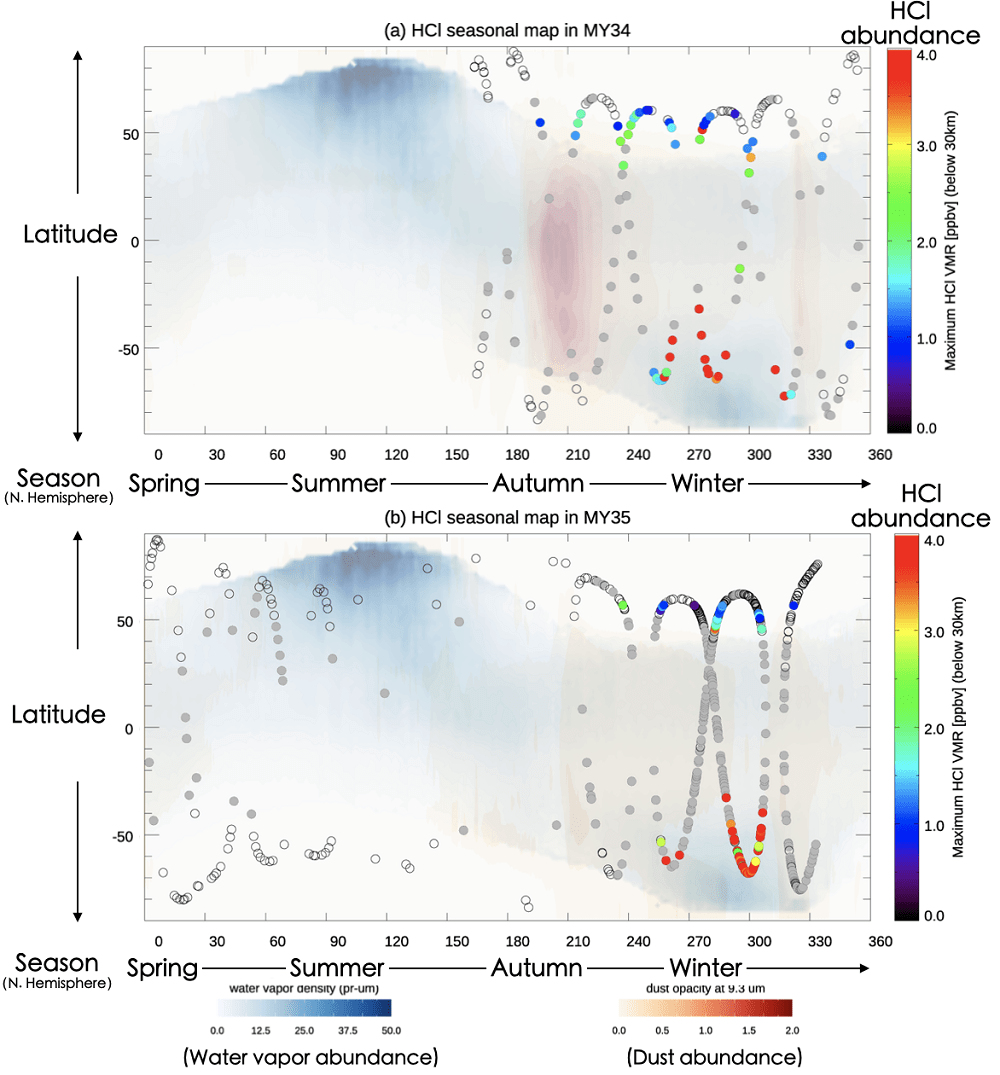Source and sink of hydrogen chloride in the atmosphere of Mars
Sep. 13, 2021 | GATEWAY to Academic Articles
It is well known that Hydrogen Chloride (HCl) plays an important role in the atmosphere of the terrestrial planets, such as ozone depletion in the Earth atmosphere and cloud formation in the Venus atmosphere. Recently, ESA’s ExoMars Trace Gas Orbiter (TGO) discovered a small amount of HCl in the Mars atmosphere. This study aims to understand the source and sink of HCl by further analysis of the TGO data. We show that a particular increase of HCl abundances in the southern summer season is annually repeated, which suggests that dust plays an important role in the formation of HCl, since dust abundances in the Mars atmosphere are relatively high in the southern summer season. We also show that the shapes of the water vapor and HCl altitude profiles are strikingly similar, which suggests that water vapor and ice clouds also play an important role in the production and loss of HCl. Moreover, we find that HCl rapidly decreases at the end of the southern summer season, which requires a strong unknown destruction process of HCl. Further study is needed to reveal the global picture of the Cl cycle on Mars including the interaction between Cl-compounds on the surface and HCl in the atmosphere.
Research Summary
Mars scientists have searched for chlorine- or sulfur-based gases as their source can be volcanic activity. Recently, Hydrogen Chloride (HCl), which is the one of main reservoirs of chlorine- gases, was discovered in the Mars atmosphere by the ACS instrument*1 onboard ESA’s ExoMars TGO*2 ,3. However, it is suggested that the detection of HCl is probably independent from any current volcanic activity on Mars because HCl is found at the same time in very distant locations, and other volcanic gases have not been detected. HCl plays an important role in the atmosphere of the terrestrial planets, such as ozone depletion in the Earth atmosphere and cloud formation in the Venus atmosphere. This study aims to understand the source and sink of HCl by further analysis of data taken by NOMAD instrument*4 onboard TGO.
One of the striking characteristics of the Martian environment is the presence of “atmospheric dust”. We show that a particular increase of HCl abundances in the southern summer season is annually repeated, which suggests that the dust plays an important role in the formation of HCl as the dust abundances in the Mars atmosphere are relatively high in the southern summer season (Fig. 1). Cl-compounds are widely detected on the surface of Mars. Atmospheric dust, including chloride-bearing materials, could release Cl into the Mars atmosphere.
We also show that the shapes of the altitude profiles of HCl and water vapor are strikingly similar, which suggests that water vapor and ice clouds also play an important role in the production and loss of HCl. Hydroperoxyl (HO2) produced by water vapor is reactive with Cl, which can be the main production process for HCl. Moreover, uptake of HCl on the water ice clouds could explain the similarity of the vertical profiles.
Finally, we also show that the HCl rapidly decreases at the end of the southern summer season (Fig. 1). It cannot be explained by the standard photochemistry on Mars, which requires an unknown strong sink process of HCl.

This study provides new insights into the Cl cycle on Mars, however, the source and sink of HCl is not fully understood. Perchlorate (ClO4-) present on the Mars surface is toxic for life. We need further research to understand the Cl cycle on Mars, including the interaction between Cl-compounds on the surface and HCl in the atmosphere, and the impact during the long history of Mars.
Terminologies
- *1 Atmospheric Chemistry Suite: A high spectral resolution infrared spectroscopy onboard Exo-Mars TGO. Developed by Space Research Institute of Russian Academy of Sciences. It carries out measurements of trace gases in the Mars atmosphere.
- *2 ExoMars Trace Gas Orbiter : ESA’s Mars orbiter operated since 2018. It has performed atmospheric measurements to search for trace gases related to geological/biological activities, and to investigate vertical structures of Mars atmosphere.
- *3 Published by “O. Korablev, K. S. Olsen, A. Trokhimovskiy, F. Lefèvre, F. Montmessin, A. Fedorova, M. Toplis, J. Alday, D. Belyaev, A. Patrakeev, N. Ignatiev, A. Shakun, A. Grigoriev, L. Baggio, I. Abdenour, G. Lacombe, Y. Ivanov, S. Aoki, I. Thomas, F. Daerden, B. Ristic, J. Erwin, M. Patel, G. Bellucci, J. J Lopez-Moreno, A. C. Vandaele, Transient HCl in the atmosphere of Mars, Science Advances, 7, (7), 2021. “
- *4 Nadir and Occultation for MArs Discovery: Another high spectral resolution infrared spectroscopy onboard Exo-Mars TGO. Developed by the Royal Belgium Institute for Space Aeronomy. It carries out measurements of trace gases in the Mars atmosphere with ACS.
- *5 Martian Years are numbered according to the calendar proposed by R. Todd Clancy (Clancy et al., Journal of Geophys. Res 105, p 9553, 2000): Martian Year 1 begins on April 11th, 1955.
Information
| Journal Title | Geophysical Research Letters |
|---|---|
| Full title of the paper | Annual Appearance of Hydrogen Chloride on Mars and a Striking Similarity With the Water Vapor Vertical Distribution Observed by TGO/NOMAD |
| DOI | https://doi.org/10.1038/s41550-021-01425-w |
| Publish date | 3 June 2021 |
| Author(s) | S. Aoki, F. Daerden, S. Viscardy, I. R. Thomas, J. T. Erwin, S. Robert, L. Trompet, L. Neary, G. L. Villanueva, G. Liuzzi, M. M. J. Crismani, R. T. Clancy, J. Whiteway, F. Schmidt, M. A. Lopez‐Valverde, B. Ristic, M. R. Patel, G. Bellucci, J.‐J. Lopez‐Moreno, K. S. Olsen, F. Lefèvre, F. Montmessin, A. Trokhimovskiy, A. A. Fedorova, O. Korablev, A. C. Vandaele |
| ISAS or JAXA member(s) among author(s) | AOKI Shohei (Dept. of Solar System Sciences) |
Links
- Discovery of HCl in the Mars atmosphere (ESA press release)
- Discovery of HCl in the Mars atmosphere (article)
- researchmap (AOKI Shohei)
- Google Scholar (AOKI Shohei)


 AOKI Shohei / Dept. of Solar System Sciences, ISAS
AOKI Shohei / Dept. of Solar System Sciences, ISAS